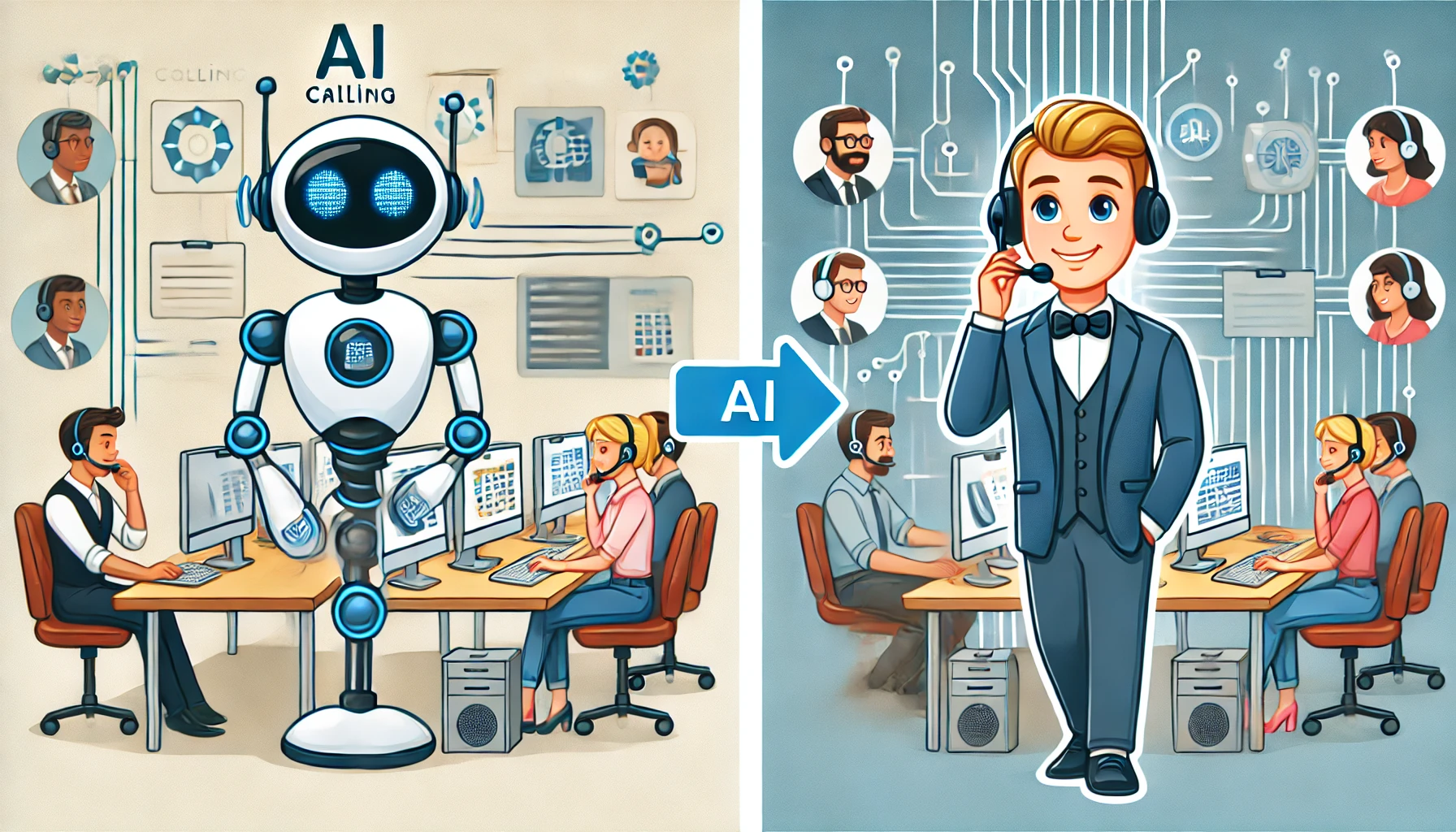Have you ever wondered how modern businesses are revolutionizing customer service? The debate between AI calling software and human operators has sparked significant interest.
AI calling software transforms how companies handle customer interactions, offering unprecedented efficiency and scalability.
But does it stack up against the traditional human touch? Let’s dive into the key differences and understand why this comparison is crucial for your business.
What is AI Calling Software?
AI calling software leverages artificial intelligence to manage and automate phone interactions. This technology can handle various tasks, from answering frequently asked questions to scheduling appointments and making outbound calls for sales and support.
Unlike traditional calling systems, AI calling software is designed to learn and improve over time, providing more accurate and efficient service as it gathers data from each interaction.
One significant advantage of AI calling software is its ability to integrate seamlessly with other business tools. For instance, it can sync with CRM systems, ensuring that customer data is always up-to-date and accessible.
This integration not only enhances the customer experience but also helps businesses streamline their operations.
Another critical aspect is the scalability of AI calling software. It can handle thousands of calls simultaneously, making it ideal for businesses experiencing high call volumes.
This capability ensures that no customer is left waiting, significantly improving response times and customer satisfaction.
AI calling software is also cost-effective. By automating repetitive tasks, businesses can reduce the need for large call center teams, cutting down on labor costs while maintaining high service standards.
Moreover, AI systems operate 24/7 without breaks, ensuring consistent service availability.
What is Traditional Calling Software?
Traditional calling software, often referred to as legacy calling systems, has been the backbone of customer service for decades. These systems typically involve human operators using telephony software to manage incoming and outgoing calls.
While these systems have evolved to incorporate features like automated menus and voicemail, they still rely heavily on human intervention.
Traditional calling software’s primary strength lies in its human element. Operators can engage in real-time, personalized conversations with customers, providing empathy and understanding that AI systems currently struggle to replicate.
This human touch is especially important in industries where customer emotions and complex problem-solving are involved, such as healthcare and insurance.
However, traditional calling systems come with several limitations. First, they are not as scalable as AI calling software. A call center can only handle as many calls as there are available operators.
During peak times, this can lead to long wait times and customer frustration. Additionally, training and managing a large team of operators can be resource-intensive and costly.
Another limitation is the consistency of service. Human operators can have off days, make errors, or provide varying levels of service quality.
While experienced operators can handle calls efficiently, new or less experienced staff might struggle, leading to inconsistencies in customer experience.
Traditional calling software also has limitations in terms of availability. Human operators need breaks, vacations, and sick days, which can impact service levels.
Unlike AI systems, traditional calling software cannot provide 24/7 service without significant investment in staffing.
In terms of integration, traditional calling systems often fall short compared to AI calling software.
While some legacy systems can integrate with modern CRM and other business tools, they often lack the seamless connectivity and real-time data updates that AI systems offer. This can result in slower response times and a less streamlined customer service process.
Key Differences Between AI Calling Software and Human Operators
Here are a few key differences between AI calling software and human operators:
1. Efficiency and Speed
AI calling software is designed to handle a high volume of calls simultaneously, a feat impossible for human operators. This efficiency is particularly beneficial during peak times or for businesses with large customer bases.
AI systems can answer calls instantly, reducing wait times and improving customer satisfaction. In contrast, human operators, no matter how skilled, are limited by the number of calls they can handle at once.
For example, imagine a business that receives hundreds of calls daily. With AI calling software, all these calls can be managed simultaneously, ensuring no customer waits on hold.
On the other hand, a team of human operators would struggle to provide the same level of efficiency, leading to longer wait times and potential customer dissatisfaction.
AI calling software also excels in speed. It can quickly access and process customer information, providing instant responses and solutions. Human operators, while capable, require time to look up information and may take longer to resolve customer issues.
This difference in speed can significantly impact the overall customer experience, making AI systems more favorable for businesses aiming for quick and efficient service.
2. Consistency and Accuracy
One of the standout features of AI calling software is its ability to deliver consistent and accurate responses. Since AI systems follow predefined algorithms and continuously learn from interactions, they provide uniform answers to customer queries.
This consistency ensures that every customer receives the same high-quality service, regardless of when they call or who they speak to.
Human operators, while capable of providing personalized service, can vary in their responses. Factors such as fatigue, mood, and experience can influence how accurately and consistently they handle calls.
For instance, an experienced operator might handle a complex query efficiently, while a newer operator might struggle, leading to inconsistent customer experiences.
Moreover, AI-calling software minimizes the risk of errors. It can quickly access and verify customer information, reducing the likelihood of mistakes. Human operators, despite their best efforts, are prone to errors, especially when dealing with large volumes of calls. This accuracy is crucial for businesses that rely on precise information, such as financial institutions and healthcare providers.
3. Personalization and Empathy
While AI calling software excels in efficiency and accuracy, it falls short in personalization and empathy. AI systems can analyze customer data to offer personalized responses, but they cannot understand and express human emotions fully.
This limitation can be a drawback in situations where empathy and emotional intelligence are crucial, such as handling complaints or providing support during stressful situations.
Human operators, on the other hand, can connect with customers on an emotional level. They can read vocal cues, express empathy, and adapt their responses based on the customer’s tone and mood.
This human touch is invaluable in building strong customer relationships and ensuring customer satisfaction.
For example, in a customer complaint scenario, a human operator can acknowledge the customer’s frustration, apologize, and offer a solution in a way that feels genuine and caring, something AI systems currently struggle to replicate.
4. Cost and Scalability
Cost is a significant factor when comparing AI calling software and human operators. Implementing AI calling software involves an initial investment, but it can lead to substantial cost savings in the long run.
Businesses can reduce labor costs as AI systems can handle tasks traditionally performed by large teams of operators. This cost-effectiveness is particularly beneficial for businesses looking to scale their operations without increasing staffing costs.
Human operators, while essential for certain tasks, come with higher ongoing costs. Hiring, training, and managing a team of operators require significant resources.
Additionally, scaling a human-operated call center involves more hiring and training, further increasing costs. AI calling software, on the other hand, can scale effortlessly to meet increasing demand without additional expenses.
5. Availability and Reliability
AI calling software offers unparalleled availability and reliability. It operates 24/7, ensuring customers can reach support at any time, day or night. This constant availability is crucial for businesses with global customers or those operating in different time zones.
AI systems do not require breaks, vacations, or downtime, ensuring consistent service delivery.
Human operators, while reliable, cannot match the around-the-clock availability of AI systems. They need breaks, and time off, and are susceptible to fatigue and illness, which can impact service levels. For businesses that require continuous support, relying solely on human operators can lead to gaps in service availability.
Moreover, AI calling software maintains a high level of reliability. It can handle large volumes of calls without errors or delays, providing consistent performance.
Human operators, despite their best efforts, can face challenges in maintaining the same level of reliability, especially during high-stress periods or peak call times.
The Importance of AI Calling Software and Human Operators
In conclusion, while AI calling software offers numerous advantages in efficiency, accuracy, scalability, and availability, human operators bring the crucial elements of personalization and empathy to customer interactions.
Businesses should consider a hybrid approach, leveraging the strengths of both AI and human operators to provide optimal customer service. AI systems can handle routine tasks and high call volumes, while human operators can focus on complex and emotionally charged interactions, ensuring a balanced and effective customer service strategy.
Conclusion
Understanding the differences between AI calling software and human operators is crucial for businesses aiming to optimize their customer service. AI calling software excels in efficiency, speed, consistency, accuracy, cost-effectiveness, and availability.
It can handle high volumes of calls simultaneously, provide uniform responses, reduce operational costs, and ensure 24/7 service.
However, human operators bring unique value to customer interactions with their ability to personalize conversations and express empathy.
They are indispensable in scenarios that require emotional intelligence and complex problem-solving, where a human touch can make a significant difference in customer satisfaction.
By combining the strengths of both AI calling software and human operators, businesses can create a robust customer service strategy. AI can manage routine and high-volume tasks, freeing up human operators to focus on interactions that benefit from a personal touch.
This hybrid approach ensures that customers receive the best of both worlds: the efficiency and reliability of AI and the empathy and personalization of human operators.



